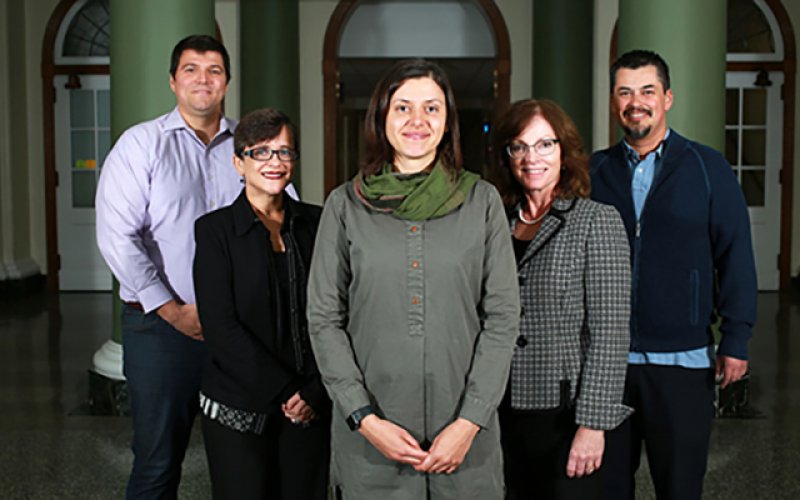Using Next-Gen Wireless Technology to Improve Emergency Response

UAlbany Researchers secure $1.5 million grant from National Science Foundation to improve broadband access in rural areas
When the 2004 Indian Ocean Tsunami struck Dec. 26 of that year it took the lives of more than 227,000 people. Despite being well into the Internet Era, warning systems on a broad international scale were nonexistent, as remote areas of Indonesia, Thailand and India suffered unfathomable loss. But 14 years later, gaps still remain in rural communities – even in the United States.
At UAlbany, researchers Mariya Zheleva and Petko Bogdanov from the College of Engineering and Applied Sciences (CEAS) are exploring ways to substantially improve the effectiveness of emergency preparedness and response (EPR) in rural communities.
Zheleva and Bogdanov – both assistant professors in the Department of Computer Science at CEAS – are working with CTG UAlbany on the project, including Associate Research Director Mila Gascó-Hernandez, Research Director J. Ramon Gil-Garcia, and Director Theresa A. Pardo.
Through a partnership with the town of Thurman, N.Y., and the Warren County Office of Emergency Services, the researchers are developing a platform for timely information collection, integration, exchange and dissemination to support EPR in rural areas.
Zheleva is serving as principal investigator, which is supported through a $1,494,805 grant from National Science Foundation (NSF).
"The Smart and Connected Communities program continues to generate innovative and collaborative research applications that are addressing challenges faced by our local communities and cities and are offering solutions to help improve people's lives," said Jim Kurose, NSF's assistant director for Computer and Information Science and Engineering, in announcing the award. "As part of our broader portfolio of investments in local communities, the NSF-WINS challenges have tapped into the creativity of teams across the country who do not typically apply to NSF to come up with solutions to the pressing challenges of internet connectivity."
Improving Broadband Delivery via ‘White Spaces’
The framework will utilize TV ‘white spaces’ – the unused channels between active broadcast TV stations – which are capable of delivering WiFi over a much broader area than currently deployed technologies. It will also leverage machine learning to optimize the scarce communication resources and improve the efficiency of emergency information dissemination.
“Rural communities, with their social and economic composition, are uniquely vulnerable to emergencies both small- and large-scale,” said Zheleva. “With this project, our aim is to leverage the wide-area wireless backhaul over TV white spaces, WiFi and pocket-switching to provide continuous communication to first responders and timely EPR information access to residents.”
“Emergency preparedness and response are essential for community well being and quality of life,” said Bogdanov. “This project will develop critical technologies for rural preparedness and response, support informed decision-making, and contribute to the social and economic revitalization of the rural communities it serves.”
The researchers also aim to design a smartphone app that can support the collection and exchange of information among first responders, government agencies and residents.
“In spearheading this new project, professors Bogdanov and Zheleva advance the CEAS mission of ‘Science in Service to Society.’ They are both prime examples of the exceptional talent, dedication, and intellectual leadership of our faculty, found across all of our disciplines,” said UAlbany College of Engineering and Applied Sciences Dean Kim Boyer. “We are extremely proud of their accomplishments, which are part of our rapidly expanding portfolio of extramurally-funded research that matters.”
“When the town board of the town of Thurman passed a resolution in 2017 in support of the work of Dr. Zheleva and her team of researchers on TV white spaces, we did so with the hope that the technology could improve the safety and well-being of the town community,” said Thurman Town Supervisor Cynthia Hyde. “We are delighted to work with UAlbany on this important research project, and we hope that the project may serve as a model for rural communities anywhere.”
“We are excited for this project to get underway for the betterment of the Thurman area,” said Brian LaFlure, Director/Fire Coordinator, Warren County Office of Emergency Services. “The white space technology and the smartphone app hold the potential to deliver consistent internet access to first responders, as well as important updates and notifications to community members town-wide.”
The team is also actively seeking research assistants to take part in the project. The part-time positions will provide students with a unique opportunity to become involved in the design of next generation mobile network technologies and their data-driven optimization, and study the adoption and impact of technological advances on rural emergency preparedness, while interacting with senior researchers in the field.
Note: Since the writing of this article, Dr. Zheleva became the recipient of the highly prestigious NSF Career Award to support her efforts to expand wireless technology.
For more information:
- National Science Foundation
- College of Engineering and Applied Sciences
- Department of Computer Science, College of Engineering and Applied Sciences
- CTG UAlbany
- UbiNET Lab
- Mariya Zheleva, Assistant Professor of Computer Science
- Petko Bogdanov, Assistant Professor of Computer Science
- Mila Gascó-Hernandez, Associate Research Director, CTG UAlbany and Associate Research Professor at Rockefeller College of Public Affairs & Policy
- J. Ramon Gil-Garcia, Research Director, CTG UAlbany and Associate Professor of Public Administration and Policy, Rockefeller College
- Theresa Pardo, Director, CTG UAlbany and Research Professor of Public Administration and Policy, Rockefeller College


